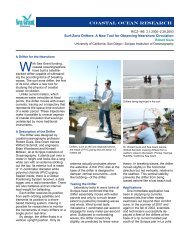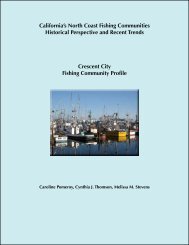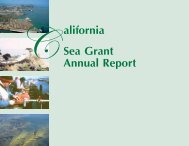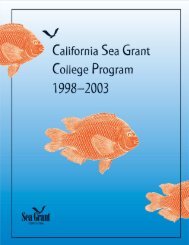California's Central Coast Marine Protected Areas - California Sea ...
California's Central Coast Marine Protected Areas - California Sea ...
California's Central Coast Marine Protected Areas - California Sea ...
Create successful ePaper yourself
Turn your PDF publications into a flip-book with our unique Google optimized e-Paper software.
elatively high numbers. Scientists also noted the presence<br />
of the deep-sea coral Lophelia here. “We are just learning<br />
about deep sea corals,” says the project’s leader Rick Starr, a<br />
<strong>California</strong> <strong>Sea</strong> Grant marine advisor based at Moss Landing<br />
<strong>Marine</strong> Laboratories. “Most are really old, more than a<br />
hundred years old. A lot have been affected by trawling.<br />
We should know more about them. In the world of the<br />
ocean, corals are important.”<br />
Portuguese Ledge SMCA<br />
Scientists observed a high diversity of fish species (68<br />
taxa) but a comparatively low density of commercially<br />
fished species. “There is something about this area that<br />
makes it very productive,” Starr says. “It has been fished<br />
for over 100 years. But there are still a lot of fish here.”<br />
Flag rockfish<br />
Rick Starr<br />
Point Lobos SMR and SMCA<br />
What is most impressive about this area is the incredible<br />
variety of invertebrates. Scientists identified, for example,<br />
10 seastar species. “We don’t really know why there are<br />
so many invertebrates,” Starr says. “But the geology and<br />
geography of the area is pretty unique. There is a lot of<br />
granite rock and you are next to the Carmel submarine<br />
canyon. The high relief and high energy probably helps.”<br />
The shallows have also been protected from exploitation<br />
since 1973.<br />
In the Conservation Area, scientists noted the predominance<br />
of dwarf rockfishes, which are less than 10-inches<br />
long and are not commercially harvested.<br />
“The prevailing hypothesis is that the bigger fish have been<br />
fished out,” Starr says. “The fish that would normally eat<br />
the little guys are gone.” Hence, the abundance of dwarf<br />
rockfishes not just at Point Lobos but at other survey sites.<br />
Point Sur SMR and SMCA<br />
Point Sur itself is a high-energy center of intense upwelling<br />
in the lea of a headland. Nearshore habitats are characterized<br />
by lots of rocky ridges and high-relief rock-sand and<br />
rock-cobble reefs. A persistent upwelling plume courses<br />
through deeper habitats. In the marine reserve, the area’s<br />
high-energy, high-relief habitat creates a haven for invertebrates,<br />
including bat seastars (41 percent), red gorgonian<br />
corals and hydrocorals (30 percent) and nipple sponges<br />
(26 percent). In the Conservation Area, fish density was<br />
high (about 65 fish per 100 square m) and about half of the<br />
observed fish were young-of-the-year rockfishes. At depths<br />
between 100 m and 200 m, pygmy, greenspotted and rosethorn<br />
rockfishes and poachers were abundant.<br />
Big Creek SMR and SMCA<br />
The marine reserve expands protection of the existing, small<br />
Big Creek Ecological Reserve established in 1990 at the<br />
southern end of Big Sur. Its shallow habitats include sandy<br />
beach, rocky intertidal, surfgrass, kelp beds, pinnacles, rock<br />
outcrops and soft sediments. Low-relief sand and mud<br />
comprised about half of the habitat. Scientists observed<br />
70 fish taxa in the marine reserve, reflecting the area’s<br />
impressive diversity of habitats. Blue rockfish (12.7 fish<br />
per 100 square m), blackeye gobies and young-of-the-year<br />
rockfishes were particularly abundant at depths less than<br />
100 m. In the Conservation Area, scientists observed 31 fish<br />
taxa, including a particularly rich abundance of flatfishes<br />
than at the other sites, reflecting the expanses of softbottom<br />
habitat in this survey area.<br />
Conclusion<br />
More than 75 percent of the state’s central coast seafloor<br />
habitat lies at depths greater than 30 m. The data collected<br />
during this project contribute substantially to depicting a<br />
snapshot of marine life in what are among the region’s most<br />
prevalent marine habitats.<br />
“As ecosystem-based management becomes more important,<br />
we will need to know more about species that are not<br />
fished,” Starr says. “Using the submersible, we are able to<br />
identify species you cannot see any other way.”<br />
Cooperating Organizations<br />
NOAA Fisheries Southwest Fisheries Science Center<br />
<strong>California</strong> Department of Fish and Game<br />
Moss Landing <strong>Marine</strong> Laboratories<br />
Washington State University at Vancouver<br />
Contact:<br />
Rick Starr<br />
<strong>California</strong> <strong>Sea</strong> Grant <strong>Marine</strong> Advisor<br />
Moss Landing <strong>Marine</strong> Laboratories<br />
831.771.4442<br />
starr@mlml.calstate.edu<br />
Fish-eating seastars on catshark eggs<br />
Rick Starr











